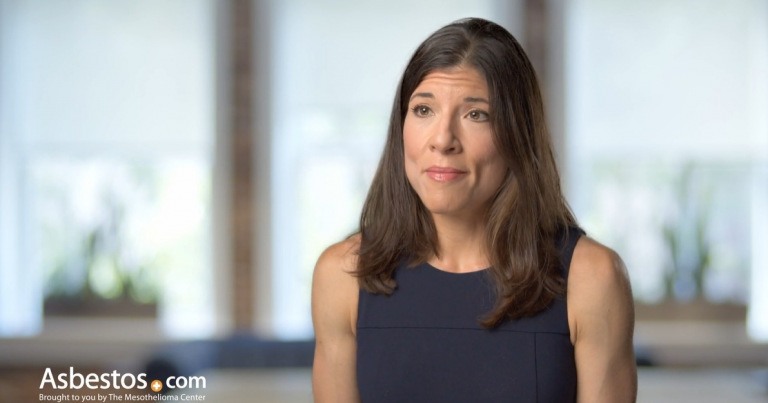
William A. Davis is an attorney specializing in complex commercial litigation, with an emphasis in health care disputes, at a firm he founded in Washington, D.C. He also serves as senior counsel at The Peterson Firm.
Most national laws trying to fully ban asbestos in the U.S. have failed. A limited number of asbestos uses are banned under various acts, but some remain legal. The Biden administration finalized a rule in March 2024 that specifically bans chrysotile asbestos.

Expert Take
Dr. Andrea Wolf: Is asbestos banned in the United States?

Expert Take
Dr. Andrea Wolf: Is asbestos banned in the United States?
Many uses of asbestos are currently banned in the United States. In March 2024, the Biden-Harris Administration finalized the U.S. Environmental Protection Agency’s ban on chrysotile asbestos, the only type of asbestos still used or imported into the country. This rule was the first regulation finalized under the 2016 Toxic Substances Control Act (TSCA) amendments.
This final rule only banned chrysotile asbestos, which had historically been used in products such as automotive brakes and linings, oilfield brake blocks, and other vehicle friction materials. Most consumer products that once contained chrysotile asbestos have already been discontinued, but the rule created enforceable timelines to phase out remaining uses.
Banned Asbestos Uses
A patchwork of laws and regulations previously banned other uses and asbestos products. For example, in 1973 the EPA banned spray-on asbestos fireproofing and insulation. In 1978, the agency banned spray-on products that were not already covered in 1973. Over the decades, the EPA has banned a growing list of products posing asbestos exposure risks.
The Occupational Safety and Health Administration defines asbestos-containing materials as those with more than 1% asbestos. Manufacturers can label any product asbestos-free if it contains less than 1% asbestos.
There are still legal uses of asbestos in the United States. The 2024 ban allows the chlor-alkali industry five years to transition from chrysotile asbestos, which it uses in diaphragms to produce chlorine and sodium hydroxide for water disinfection. This sector represents the last major industrial use of chrysotile asbestos in the U.S.
According to the U.S. Geological Survey, 224 tons of raw asbestos were imported into the country in 2022. USGS notes the chloralkali industry “has accounted for 100% of U.S. asbestos fiber consumption since no later than 2015.” There are 8 chloralkali facilities in the U.S. that still use asbestos diaphragms.
Asbestos Uses That Are Still Allowed
Most asbestos sheet gasket uses were given 2 years from the 2024 finalization. An exception to the titanium dioxide production is the Department of Energy’s Savannah River Site (a 310-square mile complex that processes and stores nuclear materials), which has until 2037 to find an alternative.
Some older products also still contain legacy asbestos. While it’s illegal to sell new products with the toxic mineral, you can still find legacy asbestos in some automotive parts, building materials, fireproofing and insulation.
5.0 rating | 150+ reviews | A+ BBB

While asbestos ban efforts have made significant progress, the EPA reports asbestos products used in vehicles and oil industry equipment were imported into the U.S. as late as 2020. Legacy asbestos products also pose a health threat to construction workers, first responders, industrial workers, mechanics, members of the military, and anyone who works inside older buildings like schools.
This is why mesothelioma advocates are still fighting to pass stricter laws like the Alan Reinstein Ban Asbestos Now Act. If approved, the law would ban all uses of commercial asbestos and asbestos-containing products. The bill was first introduced in 2019. In March 2023, the legislature read it twice and referred it to the Committee on Environment and Public Works.
Linda Reinstein, co-founder of the Asbestos Disease Awareness Organization, has been working with legislators for years to ban asbestos. “Prevention is the only cure to asbestos-caused illnesses,” she tells us. “If there is no exposure, there is no illness. By banning asbestos, we limit the exposure people have.”
Mesothelioma survivors are at the forefront of raising awareness. Survivors and their families have testified before Congress, participated in the White House’s Cancer Moonshot initiative and helped shape asbestos legislation like the Asbestos Hazard Emergency Response Act and the Fairness in Asbestos Injury Resolution Act.
U.S. federal and state laws work together to regulate the use of asbestos, covering its use and abatement. Federal laws apply nationwide and mostly affect how asbestos is used in products.
Key Facts About US Asbestos Legislation
The Asbestos Hazard Emergency Response Act of 1986, for example, regulates asbestos in schools. It orders the EPA to monitor school asbestos levels. It also established regulatory standards for inspections and abatement. All schools, public and private, must conduct asbestos inspections and develop plans for containment or removal.
Asbestos regulations in the U.S. began in the 1970s after decades of heavy use in construction and industrial products. Some uses of asbestos were banned under a patchwork of laws and regulations, such as the Clean Air Act of 1970, the 1972 Consumer Product Safety Act and the Medical Device Amendments of 1976.
Many industries profited from asbestos and resisted bans, but as the government passed laws in the 1970s and 1980s, its use declined. The growing awareness of asbestos-related diseases led consumers to demand asbestos-free products. Consumer sentiment further pushed manufacturers to phase out asbestos in their products and seek safer alternatives.
Asbestos regulations have evolved over the past century. The use, import and handling of the hazardous mineral are now strictly regulated. These regulations have helped reduce exposure.

You shouldn’t have to choose between getting care and paying for it. Get the financial support you deserve.
See My OptionsLegal challenges, historical industrial reliance and economic considerations have all contributed to the U.S. not fully banning asbestos. The construction and manufacturing industries have actively lobbied against more rigid asbestos regulations. They advocate for some continued uses of asbestos and argue asbestos abatement is too expensive.
Attempts at enforcing a full ban have historically ended with courts ruling that the costs outweigh the benefits or that improved safety measures can reduce the risks. These challenges have made passing tighter and broader regulations difficult.
However, mesothelioma advocates continue to push for a full nationwide asbestos ban. A full ban could cut the risk of cancers such as mesothelioma. It may also lower health care costs. A total ban could create an improved long-term health outlook for future generations.
Many attempts have been made to ban asbestos over the years. For example, the EPA’s 1989 Asbestos Ban and Phase-Out Rule would have banned making, importing, processing and selling asbestos products.
In October 1991, the Fifth Circuit Court of Appeals overturned the ban following an industry-backed lawsuit. The court said the EPA failed to show the ban was the “least burdensome alternative” to regulating asbestos.
Acts That Attempted to Ban Asbestos
In the absence of a national ban, some states have taken strong action to protect the public from asbestos. In June 2024, Michigan Governor Gretchen Whitmer signed bipartisan bills to protect people from asbestos exposure.
The bills address abatement projects and require public contracts to disclose certain information to the public. It also recommends an annual report on the asbestos emissions program for demolition or renovation.
Outside of the U.S., more than 60 other countries have banned the use of asbestos. In 1983, Iceland was the first country to ban all types of asbestos. In the 1980s and 1990s, Sweden, Denmark, Norway, Austria and Finland followed suit. These initial bans paved the way for global efforts to ban asbestos.
Asbestos Bans Across the World
Since 2005, the World Health Organization has fought for a global ban on asbestos to help combat the rise in mesothelioma and other asbestos-related diseases. In 2013, the WHO launched a plan to end asbestos use in its 190 member states by 2020. Unfortunately, it was never adopted.
No specific federal legislation has been passed regarding mesothelioma.
Answered By: Carl Money, Mesothelioma Attorney, Nemeroff Law Firm
Congress can pass federal asbestos laws before the president signs them. States can also regulate asbestos use. Several agencies may also regulate asbestos. These include the Environmental Protection Agency, Occupational Safety and Health Administration, Mine Safety and Health Administration and the Consumer Product Safety Commission.
Specific standards cover asbestos hazards for general industry, maritime and construction.
Excursion Limit: The EL for asbestos is 1.0 fibers per cubic centimeter over a 30-minute period.
Exposure monitoring: Employers must track asbestos exposure. They must test workers exposed at or above the permissible exposure limit for 30 or more days per year.
Medical evaluation: Employers must test the health of workers who wear negative-pressure respirators.
Notification: If lab results show that the airborne fiber limit is exceeded, employers must notify employees of the actions being taken to correct the problem.
Permissible Exposure Limit: The PEL for asbestos in the workplace is 0.1 fibers per cubic centimeter of air over an eight-hour period.
Personal protective equipment: Employers must train all workers exposed to asbestos in the use of PPE.
Workplace assessment: Employers must check their workplace for asbestos. They must also assess if work will create airborne fibers.
Written opinion: Employers must get a written opinion from a doctor. It must assess the employee’s health and fitness to wear PPE.
The asbestos reporting rule is a one-time requirement. It applies to companies that made, imported or processed asbestos from 2019 to 2022. The EPA finalized the rule under the Toxic Substances Control Act.
The TSCA requires companies to report asbestos types, amounts, uses and its presence. They must also provide employee data and the number of workers involved. The rule applies to companies with annual sales of more than $500,000 between 2019 and 2022. The EPA will use the reported information to consider future actions, such as risk evaluations and management.
Stay up-to-date on treatment, research, clinical trials, doctors and survivors
The information on this website is proprietary and protected. It is not a substitute for professional medical advice, diagnosis or treatment. Any unauthorized or illegal use, copying or dissemination will be prosecuted. Please read our privacy policy and terms of service for more information about our website.
This website and its content may be deemed attorney advertising. Prior results do not predict a similar outcome.
The Mesothelioma Center’s claim as the most trusted resource is based on our more than 150 5-star Google and BBB reviews. Our organization also helps more than half of all mesothelioma patients annually diagnosed.
Your web browser is no longer supported by Microsoft. Update your browser for more security, speed and compatibility.
If you are looking for mesothelioma support, please contact our Patient Advocates at (855) 404-4592
The Mesothelioma Center at Asbestos.com has provided patients and their loved ones the most updated and reliable information on mesothelioma and asbestos exposure since 2006.
Our team of Patient Advocates includes a medical doctor, a registered nurse, health services administrators, veterans, VA-accredited Claims Agents, an oncology patient navigator and hospice care expert. Their combined expertise means we help any mesothelioma patient or loved one through every step of their cancer journey.
More than 30 contributors, including mesothelioma doctors, survivors, health care professionals and other experts, have peer-reviewed our website and written unique research-driven articles to ensure you get the highest-quality medical and health information.
My family has only the highest compliment for the assistance and support that we received from The Mesothelioma Center. This is a staff of compassionate and knowledgeable individuals who respect what your family is experiencing and who go the extra mile to make an unfortunate diagnosis less stressful. Information and assistance were provided by The Mesothelioma Center at no cost to our family.LashawnMesothelioma patient’s daughter


Lahav, J. (2025, November 4). Asbestos Legislation and Bans in the US. Asbestos.com. Retrieved January 8, 2026, from https://www.asbestos.com/mesothelioma-lawyer/legislation/
Lahav, Joe. "Asbestos Legislation and Bans in the US." Asbestos.com, 4 Nov 2025, https://www.asbestos.com/mesothelioma-lawyer/legislation/.
Lahav, Joe. "Asbestos Legislation and Bans in the US." Asbestos.com. Last modified November 4, 2025. https://www.asbestos.com/mesothelioma-lawyer/legislation/.
A mesothelioma lawyer who specializes in asbestos litigation reviewed the content on this page to ensure it is legally accurate.

William A. Davis is an attorney specializing in complex commercial litigation, with an emphasis in health care disputes, at a firm he founded in Washington, D.C. He also serves as senior counsel at The Peterson Firm.
Our fact-checking process begins with a thorough review of all sources to ensure they are high quality. Then we cross-check the facts with original medical or scientific reports published by those sources, or we validate the facts with reputable news organizations, medical and scientific experts and other health experts. Each page includes all sources for full transparency.
Please read our editorial guidelines to learn more about our content creation and review process.
